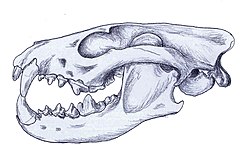Sunkahetanka
Appearance
| Sunkahetanka Temporal range:
| |
|---|---|

| |
| Sunkahetanka geringensis | |
| Scientific classification | |
| Kingdom: | Animalia |
| Phylum: | Chordata |
| Class: | Mammalia |
| Order: | Carnivora |
| Suborder: | Caniformia |
| Family: | Canidae |
| Subfamily: | †Hesperocyoninae |
| Genus: | †Sunkahetanka Macdonald, 1963 |
| Species: | †S. geringensis
|
| Binomial name | |
| †Sunkahetanka geringensis Barbour & Schultz, 1935
| |
Sunkahetanka is an extinct monospecific genus of the Hesperocyoninae subfamily of early canids native to North America. It lived during the Oligocene, 30.8—26.3 Ma, existing for approximately 5 million years.[1] In form, it was intermediate between the small Cynodesmus and the later Enhydrocyon, the first hypercarnivorous, "bone-cracking", canid.[2]
References
[edit]- ^ [1] Sunkahetanka
- ^ Wang, Xiaoming; Tedford, Richard H. (2008). Dogs, Their Fossil Relatives and Evolutionary History. Columbia. p. 25. ISBN 978-0-231-13528-3.
- Wang, X. 1994. Phylogenetic systematics of the Hesperocyoninae (Carnivora, Canidae). Bulletin of the American Museum of Natural History, 221:1-207.










